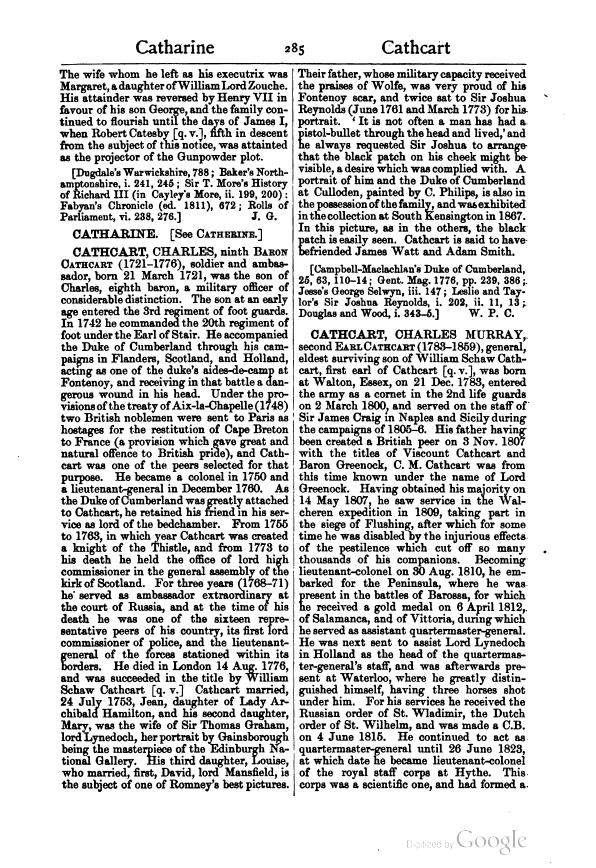The wife whom he left as his executrix was Margaret, a daughter of William Lord Zouche. His attainder was reversed by Henry VII in favour of his son George, and the family continued to flourish until the days of James I, when Robert Catesby [q. v.], fifth in descent from the subject of this notice, was attainted as the projector of the Gunpowder plot.
[Dugdale's Warwickshire, 788; Baker's Northamptonshire, i. 241, 245; Sir T. More's History of Richard III (in Cayley's More, ii. 199, 200); Fabyan's Chronicle (ed. 1811), 672; Rolls of Parliament, vi. 238, 276.]
CATHARINE. [See Catherine.]
CATHCART, CHARLES, ninth Baron Cathcart (1721–1776), soldier and ambassador, born 21 March 1721, was the son of Charles, eighth baron, a military officer of considerable distinction. The son at an early age entered the 3rd regiment of foot guards. In 1742 he commanded the 20th regiment of foot under the Earl of Stair. He accompanied the Duke of Cumberland through his campaigns in Flanders, Scotland, and Holland, acting as one of the duke's aides-de-camp at Fontenoy, and receiving in that battle a dangerous wound in his head. Under the provisions of the treaty of Aix-la-Chapelle (1748) two British noblemen were sent to Paris as hostages for the restitution of Cape Breton to France (a provision which gave great and natural offence to British pride), and Cathcart was one of the peers selected for that purpose. He became a colonel in 1750 and a lieutenant-general in December 1760. As the Duke of Cumberland was greatly attached to Cathcart, he retained his friend in his service as lord of the bedchamber. From 1755 to 1763, in which year Cathcart was created a knight of the Thistle, and from 1773 to his death he held the office of lord high commissioner in the general assembly of the kirk of Scotland. For three years (1768–71) he served as ambassador extraordinary at the court of Russia, and from 1752 till his death he was one of the sixteen representative peers of his country, its first lord commissioner of police, and the lieutenant-general of the forces stationed within its borders. He died in London 14 Aug. 1776, and was succeeded in the title by William Schaw Cathcart [q. v.] Cathcart married, 24 July 1753, Jean, daughter of Lady Archibald Hamilton, and his second daughter, Mary, was the wife of Sir Thomas Graham, lord Lynedoch, her portrait by Gainsborough being the masterpiece of the Edinburgh National Gallery. His third daughter, Louise, who married, first, David, lord Mansfield, is the subject of one of Romney's best pictures. Their father, whose military capacity received the praises of Wolfe, was very proud of his Fontenoy scar, and twice sat to Sir Joshua Reynolds (June 1761 and March 1773) for his portrait. ‘It is not often a man has had a pistol-bullet through the head and lived,’ and he always requested Sir Joshua to arrange that the black patch on his cheek might be visible, a desire which was complied with. A portrait of him and the Duke of Cumberland at Culloden, painted by C. Philips, is also in the possession of the family, and was exhibited in the collection at South Kensington in 1867. In this picture, as in the others, the black patch is easily seen. Cathcart is said to have befriended James Watt and Adam Smith.
[Campbell-Maclachlan's Duke of Cumberland, 25, 63, 110–14; Gent. Mag. 1776, pp. 239, 386; Jesse's George Selwyn, iii. 147; Leslie and Taylor's Sir Joshua Reynolds, i. 202, ii. 11, 13; Douglas and Wood, i. 343–5.]
CATHCART, CHARLES MURRAY, second Earl Cathcart (1783–1859), general, eldest surviving son of William Schaw Cathcart, first earl of Cathcart [q. v.], was born at Walton, Essex, on 21 Dec. 1783, entered the army as a cornet in the 2nd life guards on 2 March 1800, and served on the staff of Sir James Craig in Naples and Sicily during the campaigns of 1805–6. His father having been created a British peer on 3 Nov. 1807 with the titles of Viscount Cathcart and Baron Greenock, C. M. Cathcart was from this time known under the name of Lord Greenock. Having obtained his majority on 14 May 1807, he saw service in the Walcheren expedition in 1809, taking part in the siege of Flushing, after which for some time he was disabled by the injurious effects of the pestilence which cut off so many thousands of his companions. Becoming lieutenant-colonel on 30 Aug. 1810, he embarked for the Peninsula, where he was present in the battles of Barossa, for which he received a gold medal on 6 April 1812, of Salamanca, and of Vittoria, during which he served as assistant quartermaster-general. He was next sent to assist Lord Lynedoch in Holland as the head of the quartermaster-general's staff, and was afterwards present at Waterloo, where he greatly distinguished himself, having three horses shot under him. For his services he received the Russian order of St. Wladimir, the Dutch order of St. Wilhelm, and was made a C.B. on 4 June 1815. He continued to act as quartermaster-general until 26 June 1823, at which date he became lieutenant-colonel of the royal staff corps at Hythe. This corps was a scientific one, and had formed a
